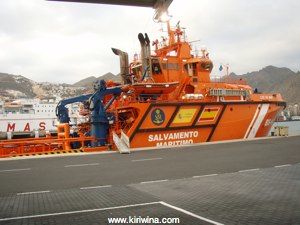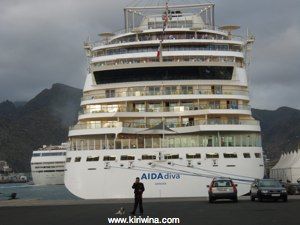Tenerife
Varados Anaga departure, Santa Cruz
21/12/07 19:15
An 08:00 start today as we had lots to do.
New anodes were fitted, the fresh water tanks and jerry can filled and the propellor greased. I read somewhere that greasing the propellor slows down fouling. We shall see.
The bill was paid. A reasonable €259 for a lift-out, pressure wash, 8 days ashore (living on board) and lift-in.
Our hull had been marked at lift-out by residual antifouling on the lifting strops. At lift-in we made sure cardboard inserts were used to avoid this.
After a short delay caused by the entry gate getting jammed Varaderos Anaga staff put Kiriwina back in the water.
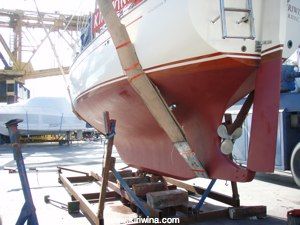
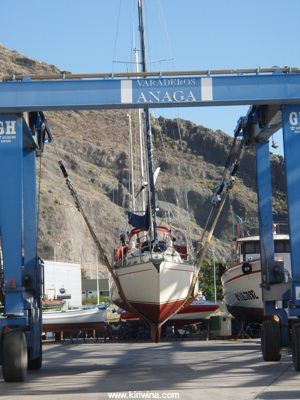
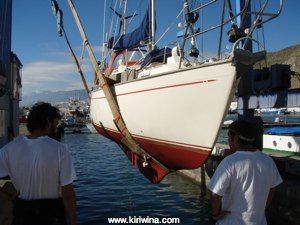
We moored on the Varaderos Anaga pontoon, with Santa Cruz in the background, for a couple of hours before sailing. There were a few things to do.
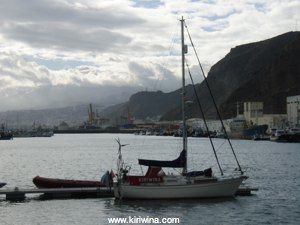
First stop was BlancoMar where I purchased some rope, eye pads and a couple of courtesy flags that may be needed in the Caribbean. Then we had lunch, sent some e-mails and returned to the boat.
It was 16:30 before we sailed. Once clear of Darsena Pesquera we were able to sail for abut an hour before the wind died completely and we continued under engine.
A fast ferry with it's huge wake leaving Santa Cruz, Tenerife.
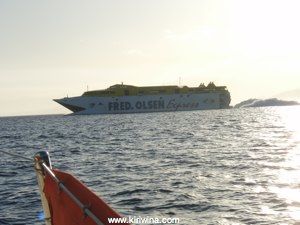
Our last look at Santa Cruz, Tenerife.
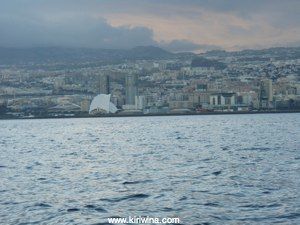
For the rest of the evening we motor sailed.
New anodes were fitted, the fresh water tanks and jerry can filled and the propellor greased. I read somewhere that greasing the propellor slows down fouling. We shall see.
The bill was paid. A reasonable €259 for a lift-out, pressure wash, 8 days ashore (living on board) and lift-in.
Our hull had been marked at lift-out by residual antifouling on the lifting strops. At lift-in we made sure cardboard inserts were used to avoid this.
After a short delay caused by the entry gate getting jammed Varaderos Anaga staff put Kiriwina back in the water.



We moored on the Varaderos Anaga pontoon, with Santa Cruz in the background, for a couple of hours before sailing. There were a few things to do.

First stop was BlancoMar where I purchased some rope, eye pads and a couple of courtesy flags that may be needed in the Caribbean. Then we had lunch, sent some e-mails and returned to the boat.
It was 16:30 before we sailed. Once clear of Darsena Pesquera we were able to sail for abut an hour before the wind died completely and we continued under engine.
A fast ferry with it's huge wake leaving Santa Cruz, Tenerife.

Our last look at Santa Cruz, Tenerife.

For the rest of the evening we motor sailed.
Varados Anaga, Santa Cruz
20/12/07 20:17
19th December 2007
It rained again this morning so I went into town to get our anodes and a few other bits and pieces from BlancoMar. This time they were open. The anodes were an eye watering €62 each. Their suppliers excuse was that zinc has shot up in price. It was below £1000 per tonne in 2002 and is now well above £2000 having peaked at around £4,500 in 2006. Bet they don't put the anode price back down though.
I also bought a couple of spherical fenders.
On the way back I dropped in at La Marina, a fishermans chandlery, to buy two 5m lengths of chain for mooring alongside stone quays where the bollards are set back from the quayside.
By the afternoon things dried out completely and we were able to apply primer to the hull where required. I also overhauled the sea-cocks and fitted wood bungs to several through hull valves which lacked them.
If it doesn't rain tomorrow we should be able to apply the anti-fouling paint.
20th December 2007
No problem with the weather. It was fine and clear.
We started applying the anti-fouling and it became apparent very quickly that 2.5 litres would not be enough. Ouch! back to the paint shop for another 2.5 litres of Jotun Penguin NonStop at €104. This product is reportedly banned in some countries including the UK. It will be interesting to see how well it works.
By the end of the day we had applied two complete coats (total 5 litres) of antifouling and will be ready to launch tomorrow.
It rained again this morning so I went into town to get our anodes and a few other bits and pieces from BlancoMar. This time they were open. The anodes were an eye watering €62 each. Their suppliers excuse was that zinc has shot up in price. It was below £1000 per tonne in 2002 and is now well above £2000 having peaked at around £4,500 in 2006. Bet they don't put the anode price back down though.
I also bought a couple of spherical fenders.
On the way back I dropped in at La Marina, a fishermans chandlery, to buy two 5m lengths of chain for mooring alongside stone quays where the bollards are set back from the quayside.
By the afternoon things dried out completely and we were able to apply primer to the hull where required. I also overhauled the sea-cocks and fitted wood bungs to several through hull valves which lacked them.
If it doesn't rain tomorrow we should be able to apply the anti-fouling paint.
20th December 2007
No problem with the weather. It was fine and clear.
We started applying the anti-fouling and it became apparent very quickly that 2.5 litres would not be enough. Ouch! back to the paint shop for another 2.5 litres of Jotun Penguin NonStop at €104. This product is reportedly banned in some countries including the UK. It will be interesting to see how well it works.
By the end of the day we had applied two complete coats (total 5 litres) of antifouling and will be ready to launch tomorrow.
Santa Cruz - Varaderos Anaga
18/12/07 18:57
Up early to do the final preparations for anti fouling.
Before starting we had a very good breakfast at a dockside kiosk nearby. The weather forecast yesterday had been for heavy rain today and tomorrow. Last night Tomas consulted a local angler as to the possibility of rain. Tomas likes to speak to the locals and is always asking for directions or information. I remain sceptical as the information gained is more often wrong than right. Anyway, the local assured us that it would not rain today. The air temperature was too cold.
Just after breakfast the heavens opened and it poured. There would be no painting today. We went to La Marina, a local chandlery, to buy some anodes but they didn't have our size. We were, however able to buy 2.5 litres of Jotun Nonstop antifouling paint. This quantity was sufficient when I last did the job.
We planned to try BlancoMar in Santa Cruz for the anodes later in the afternoon. When we got there around 18:30 it was closed.
Before starting we had a very good breakfast at a dockside kiosk nearby. The weather forecast yesterday had been for heavy rain today and tomorrow. Last night Tomas consulted a local angler as to the possibility of rain. Tomas likes to speak to the locals and is always asking for directions or information. I remain sceptical as the information gained is more often wrong than right. Anyway, the local assured us that it would not rain today. The air temperature was too cold.
Just after breakfast the heavens opened and it poured. There would be no painting today. We went to La Marina, a local chandlery, to buy some anodes but they didn't have our size. We were, however able to buy 2.5 litres of Jotun Nonstop antifouling paint. This quantity was sufficient when I last did the job.
We planned to try BlancoMar in Santa Cruz for the anodes later in the afternoon. When we got there around 18:30 it was closed.
Santa Cruz - Varaderos Anaga
17/12/07 18:56
My booking had been changed to the first flight out of El Hierro for Tenerife at 08:40. This meant an early start.
I went down to check out at 06:30. A bleary eyed duty receptionist emerged when I rang the bell but she was unable to prepare my bill. I some details and my phone number for the day receptionist.
Outside it was still very dark. I drove quietly along the west coast road, through the long tunnel and across to the airport stopping for a while to watch the sun come up.
I got to the airport just after 07:30. Binter might have expensive fares but their check-in is very quick. This time it took less than a minute. The day receptionist from Hotel Balneario called and I paid the bill.
First flight of the day from El Hierro.
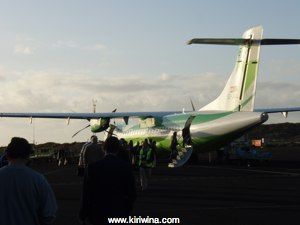
The flight was on time and I was back on board by 11:00. The rest of the day was spent sanding the hull in preparation for antifouling. A very dirty job.
Late in the day Tomas returned from his birthday trip to Madrid and we into Santa Cruz for dinner at La Hierbita.
I went down to check out at 06:30. A bleary eyed duty receptionist emerged when I rang the bell but she was unable to prepare my bill. I some details and my phone number for the day receptionist.
Outside it was still very dark. I drove quietly along the west coast road, through the long tunnel and across to the airport stopping for a while to watch the sun come up.
I got to the airport just after 07:30. Binter might have expensive fares but their check-in is very quick. This time it took less than a minute. The day receptionist from Hotel Balneario called and I paid the bill.
First flight of the day from El Hierro.

The flight was on time and I was back on board by 11:00. The rest of the day was spent sanding the hull in preparation for antifouling. A very dirty job.
Late in the day Tomas returned from his birthday trip to Madrid and we into Santa Cruz for dinner at La Hierbita.
Santa Cruz - Varaderos Anaga
14/12/07 16:54
Last night we met a group of Germans at La Hierbita. They were from this lovely barque "Alexander Von Humboldt".
Her hull is 100 years old and started life as a Weser light ship. She was converted to a barque in 1988 and is owned by a trust with an active membership who can book a passage on here and become part of the crew, In the summer she sails in the baltic and scandinavian waters and in the winter the Canaries.
Sadly, because of her aging hull, she is unlikely to pass her next survey and the trust are looking for a sponsor to fund her replacement.
I was invited aboard but most crew were ashore when I arrived so I just had a good look from the dock.
A lovely ship. The sails are real canvas and here rig is as traditional as possible.
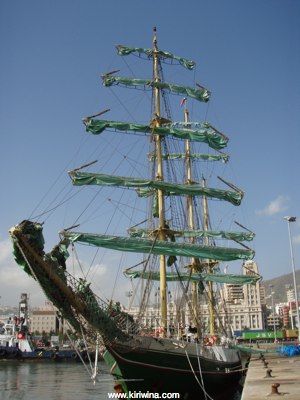
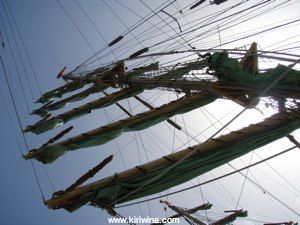
Back on board I spent the afternoon scraping bits of dead sea critters off the hull and propellor and removing the old anodes.
Her hull is 100 years old and started life as a Weser light ship. She was converted to a barque in 1988 and is owned by a trust with an active membership who can book a passage on here and become part of the crew, In the summer she sails in the baltic and scandinavian waters and in the winter the Canaries.
Sadly, because of her aging hull, she is unlikely to pass her next survey and the trust are looking for a sponsor to fund her replacement.
I was invited aboard but most crew were ashore when I arrived so I just had a good look from the dock.
A lovely ship. The sails are real canvas and here rig is as traditional as possible.


Back on board I spent the afternoon scraping bits of dead sea critters off the hull and propellor and removing the old anodes.
Santa Cruz - Marina Atlantico to Varaderos Anaga
13/12/07 19:59
We had contacted Varaderos Anaga about being hauled out but they had no spare cradles. This morning they called. A cradle was available so we said we would come immediately.
Heavy overnight rain seemed to have flooded the sewers and as we left the harbour water was an unusual brown colour and gave off a very unpleasant smell.
On the way out we passed the German barque "Alexander von Humboldt" on her way in.
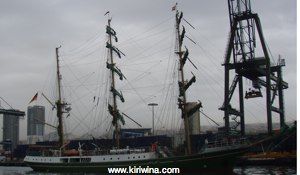
Outside the harbour we were thrown about all over the place as Kiriwina rolled heavily in short steep seas. It was only about 4 miles up to Varaderos Anaga and gradually the seas eased as we approached the fishing harbour.
Proceeding up Santa Cruz fishing harbour.
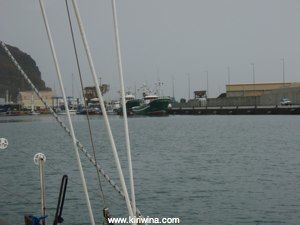
It rained heavily for most of this short passage and continued once we arrived at the yard.
No problems with our forestay at this yard but they still wanted me to lash the lifting strops together as a precaution against slippage.
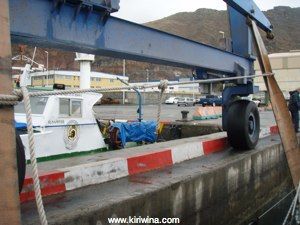
Varaderos Anaga were very efficient and hauled us out without problem.
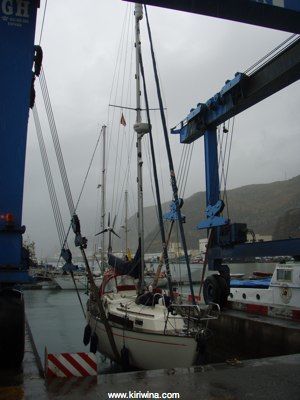
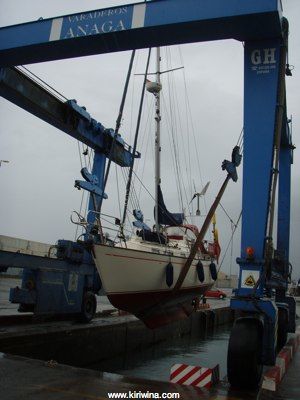
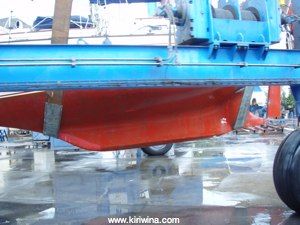
Hosing us down they decided to use a metal scraper to remove the more stubborn fouling. I was later to discover that they had been a little over enthusiastic doing this.
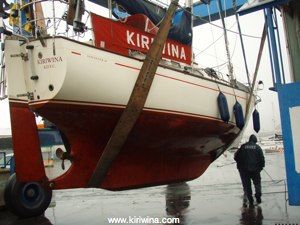
Kiriwina was sat in a steel cradle on wooden blocks. Everything was very secure.
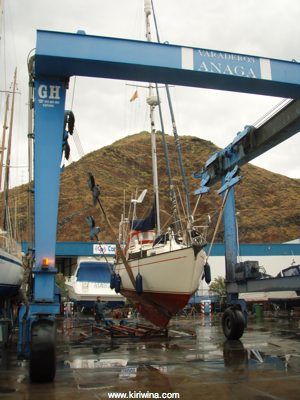
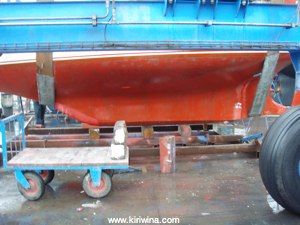
The yard has toilets, hot showers and 24 hour security. Boat owners can live on board and work on their boat.
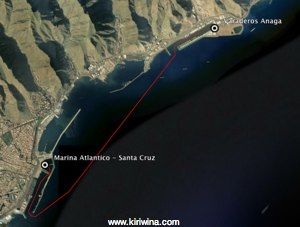
Heavy overnight rain seemed to have flooded the sewers and as we left the harbour water was an unusual brown colour and gave off a very unpleasant smell.
On the way out we passed the German barque "Alexander von Humboldt" on her way in.

Outside the harbour we were thrown about all over the place as Kiriwina rolled heavily in short steep seas. It was only about 4 miles up to Varaderos Anaga and gradually the seas eased as we approached the fishing harbour.
Proceeding up Santa Cruz fishing harbour.

It rained heavily for most of this short passage and continued once we arrived at the yard.
No problems with our forestay at this yard but they still wanted me to lash the lifting strops together as a precaution against slippage.

Varaderos Anaga were very efficient and hauled us out without problem.



Hosing us down they decided to use a metal scraper to remove the more stubborn fouling. I was later to discover that they had been a little over enthusiastic doing this.

Kiriwina was sat in a steel cradle on wooden blocks. Everything was very secure.


The yard has toilets, hot showers and 24 hour security. Boat owners can live on board and work on their boat.

Santa Cruz - Marina Atlantico
08/12/07 18:42
Marina Atlantico - Santa Cruz
07/12/07 12:33
We decided to move to Marina Atlantico in Santa Cruz. There are good haul-out facilities nearby the shelter within the marina is much better, particularly from swell.
Leaving Puerto de Radazul.
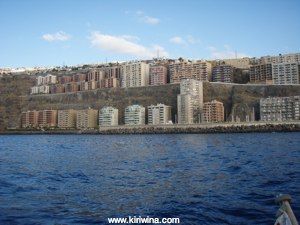
It is only a short trip up the coast and when we left Puerto de Radazul at 09:30 there was virtually no wind. Within an hour we had winds gusting 20 knots from ahead. The 6 mile trip took about two hours.
The "Talon" viewed from seaward.
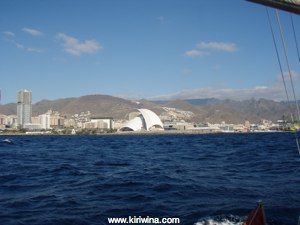
At Marina Atlantico our berth #31 on pontoon two was conveniently located adjacent to their brand new amenities block.
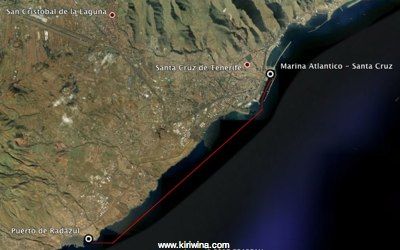
Leaving Puerto de Radazul.

It is only a short trip up the coast and when we left Puerto de Radazul at 09:30 there was virtually no wind. Within an hour we had winds gusting 20 knots from ahead. The 6 mile trip took about two hours.
The "Talon" viewed from seaward.

At Marina Atlantico our berth #31 on pontoon two was conveniently located adjacent to their brand new amenities block.

Puerto de Radazul
06/12/07 19:53
Maintenance day today.
I installed two more Bebi LED lights in the cabin. This completed our conversion to LED for all interior lighting.
Our Plastimo contest compass is fitted with an upper and lower lightbulb. Since delivery the upper had not worked. I had sourced some spare bulbs.
The missing bulb was still connected but had been removed from it's housing and left to dangle in the bulkhead void.
Replacement was difficult. Whoever did the original wiring never envisaged the possibility of bulb replacement. I had to cut the lower bulb wire, lengthen the feed wire by about 8 inches and fit a block connector. This allowed easy re-connection of both compass lights and will enable bulb changes to be done in 5 minutes.
Later we went into Santa Cruz for dinner and caught the last bus back at 21:40.
Buses are the main form of public transport on Tenerife and the new bus terminal is quite eye catching. Particularly the service identification signs.
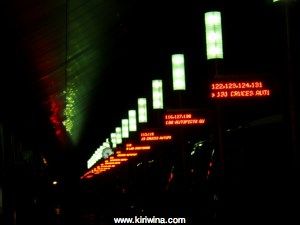
Our bus.
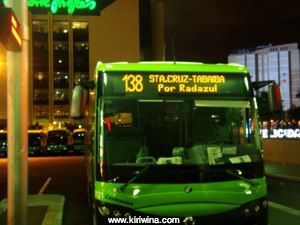
I installed two more Bebi LED lights in the cabin. This completed our conversion to LED for all interior lighting.
Our Plastimo contest compass is fitted with an upper and lower lightbulb. Since delivery the upper had not worked. I had sourced some spare bulbs.
The missing bulb was still connected but had been removed from it's housing and left to dangle in the bulkhead void.
Replacement was difficult. Whoever did the original wiring never envisaged the possibility of bulb replacement. I had to cut the lower bulb wire, lengthen the feed wire by about 8 inches and fit a block connector. This allowed easy re-connection of both compass lights and will enable bulb changes to be done in 5 minutes.
Later we went into Santa Cruz for dinner and caught the last bus back at 21:40.
Buses are the main form of public transport on Tenerife and the new bus terminal is quite eye catching. Particularly the service identification signs.

Our bus.

Puerto de Radazul
05/12/07 20:15
This life of leisure can get quite hectic at times. It was nice to sleep in this morning. At shower time we were down to one working shower/toilet block in the marina. Puerto Radazul seem to be having some serious plumbing problems.
Our first job was to stow all the dry stores and 80 litres of bottled water we bought yesterday. Kiriwina is not a big boat but she has a lot of storage capacity. After around 3 hours everything was safely stowed away and a "where is it" list made.
Kiriwina needs her bottom cleaned and antifouled. We had arranged a haul-out for 15:00.
Kiriwina entering the haul-out dock at Puerto de Radazul. They had chosen to use the smaller of their two straddle hoists.
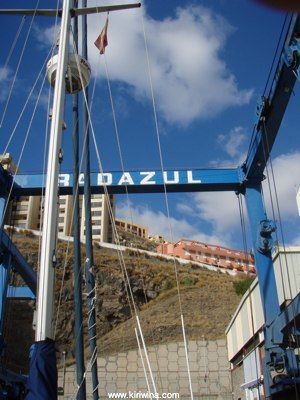
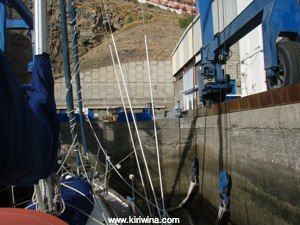
Houston, we have a problem!
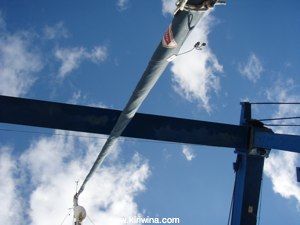
The small straddle hoist has too small. It could not move far enough aft. No problem said the yard crew just disconnect the forestay/furling gear. "Er, but it's holding up the mast" said the skipper. "We will tie some rope to it" they said.
Disconnecting the forestay/furling gear was not an option I was prepared to consider in these circumstances. Had we gone in astern they would have wanted the backstays disconnected. The haul-out was cancelled.
Our first job was to stow all the dry stores and 80 litres of bottled water we bought yesterday. Kiriwina is not a big boat but she has a lot of storage capacity. After around 3 hours everything was safely stowed away and a "where is it" list made.
Kiriwina needs her bottom cleaned and antifouled. We had arranged a haul-out for 15:00.
Kiriwina entering the haul-out dock at Puerto de Radazul. They had chosen to use the smaller of their two straddle hoists.


Houston, we have a problem!

The small straddle hoist has too small. It could not move far enough aft. No problem said the yard crew just disconnect the forestay/furling gear. "Er, but it's holding up the mast" said the skipper. "We will tie some rope to it" they said.
Disconnecting the forestay/furling gear was not an option I was prepared to consider in these circumstances. Had we gone in astern they would have wanted the backstays disconnected. The haul-out was cancelled.
La Laguna and Santa Cruz
04/12/07 20:36
Another far too early start. We had to be at Inprecasa to give them some glasses for stowage in the liferaft and two fire extinguishers for refill.
Our final tourist trip was to La Laguna, a World Heritage site just north of Santa Cruz. It was certainly a very attractive place with wide paved streets and a number of historic buildings as it was the original capital of Tenerife. For me, the wow factor was not very high and I couldn't see why the town justified World Heritage status.
Courtyard in the Museum of the History of Tenerife. The building dating from the 15th century was originally home to a family of Italian settlers. I found the collection of early nautical charts very interesting.
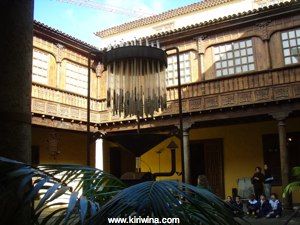
We returned to Inprecasa to collect the liferaft and fire extinguishers and to purchase an additional pack of flares. A very efficient company to deal with although for reasons not unconnected with Spanish legislation our 3 year service interval on the liferaft had been reduced to 1.
Santa Cruz is the last large town before we sail for the Cape verde islands and Brazil. It was time to visit El Corte Ingles to stock up. We filled two large shopping trolleys with mainly dry stores and bottled water.
We drove back to Puerto de Radazul to unload before returning to Santa Cruz to return our hire car.
For several years Marina Atlantico has had a reputation as being one of the most expensive marinas in the Canaries and one of the worst. We went to have a look. The location is terrific. Just opposite Plaza de España near the centre of Santa Cruz. Just last week...
...this facilities block was closed and...
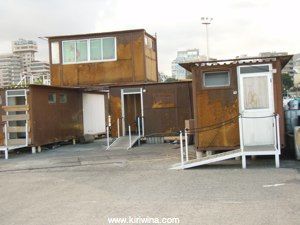
...this one was opened.
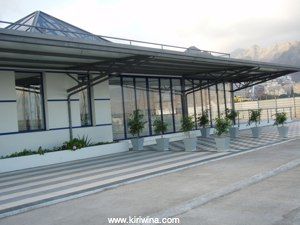
Had we known it might have be worth calling at Santa Cruz.
Our final tourist trip was to La Laguna, a World Heritage site just north of Santa Cruz. It was certainly a very attractive place with wide paved streets and a number of historic buildings as it was the original capital of Tenerife. For me, the wow factor was not very high and I couldn't see why the town justified World Heritage status.
Courtyard in the Museum of the History of Tenerife. The building dating from the 15th century was originally home to a family of Italian settlers. I found the collection of early nautical charts very interesting.

We returned to Inprecasa to collect the liferaft and fire extinguishers and to purchase an additional pack of flares. A very efficient company to deal with although for reasons not unconnected with Spanish legislation our 3 year service interval on the liferaft had been reduced to 1.
Santa Cruz is the last large town before we sail for the Cape verde islands and Brazil. It was time to visit El Corte Ingles to stock up. We filled two large shopping trolleys with mainly dry stores and bottled water.
We drove back to Puerto de Radazul to unload before returning to Santa Cruz to return our hire car.
For several years Marina Atlantico has had a reputation as being one of the most expensive marinas in the Canaries and one of the worst. We went to have a look. The location is terrific. Just opposite Plaza de España near the centre of Santa Cruz. Just last week...
...this facilities block was closed and...

...this one was opened.

Had we known it might have be worth calling at Santa Cruz.
Santa Cruz and NE Coast
03/12/07 18:46
The alarm went off at 06:30. Far too early for this leisure mariner.
But needs must. We had to be at Imprecasa, a marine servicing company, for an 08:00 appointment to get our liferaft inspected and serviced.
They are in the north of Santa Cruz. We got lost and were late.
Our liferaft is a "Forties B" 4 man valise model manufactured by RFD, a division of Survitec who are a sort of safety conglomerate.
Firstly the liferaft is removed from it's valise and the vacuum bag removed. They had to be careful as this bag (the silver foil piece at the bottom) would have to be used again due to non availabilty of spares from RFD/Survitec. The raft is only 2 years old.
Then the raft was unfolded and the gas cylinder removed. The cylinder will be tested and recharged if necessary.
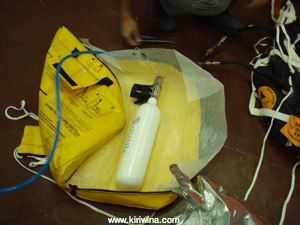
Compressed air is used to first inflate the lower chamber...
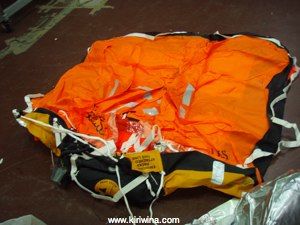
... and then the upper chamber and canopy supports.
A rear view of the fully inflated raft with circular peephole just visible.
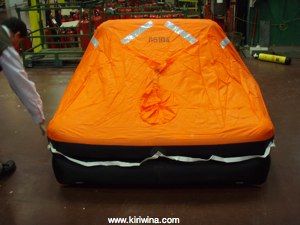
Liferaft entrance. Note insulated floor and internal webbing ladder to assist boarding.
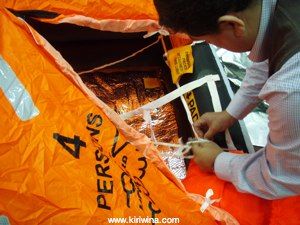
Our fully inflated raft with orange stability pouches underneath.
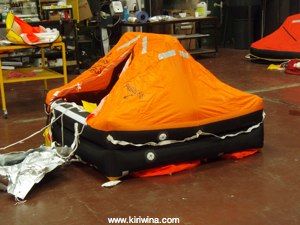
This liferaft has an RORC pack which will be inspected and consumable items such as flares and batteries replaced together with any faulty components found. The raft has no food or water. These are provided using our grab bag.
We will return tomorrow for the re-packing. I plan to include a set of specs. These can be accommodated but very little else can be added.
Tomas needed to get some vaccinations done in Santa Cruz. When he was finished we set off for the north east part of Tenerife.
The island here is quite mountainous with deep valleys and dramatic but well maintained switchback roads. Road engineering in the Canaries is pretty impressive.
From what we have seen over the past few days and this morning normal Spanish service has been resumed in that the built environment on Tenerife is a bit of a mess. The innovative approach to planning and building design used on much of Lanzarote is sadly absent here.
We drove up to the Vallee de Guerra and then onto the coast at Punta Hidalgo. Our route then turned inland via Tejina and Tegueste and climbed up into the outstanding Monte de las Mercedes.
Steep mountain valleys in Monte de las Mercedes with switchback roads. The forest here is very dense but the trees are not particularly large.
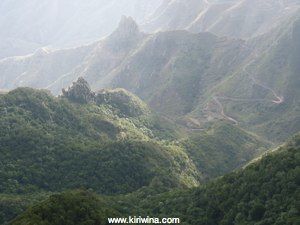
Moist sea air sweeps up the north face and rolls over into the valleys.
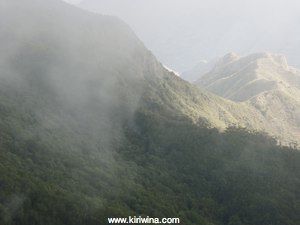
Higher on the very moist north facing slopes the trees appear somewhat stunted and are overgrown with lichen.
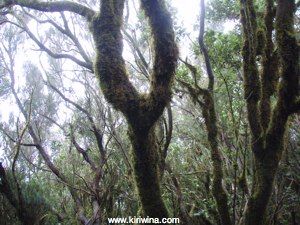
Dropping down from Monte de las Mercedes we drove through Taganana and on down to the black sandy beach at Playa de San Roque where quite a surf was running.
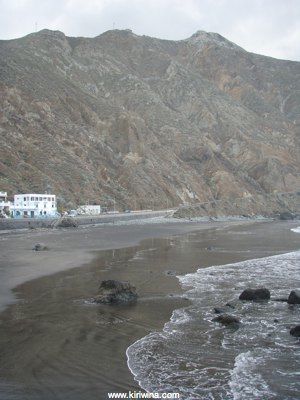
Our route then wound down to the east coast at San Andres where we came across a little piece of paradise at Playa de Las Teresitas. How idyllic and what a change from the rugged coast and black sandy beach just a few miles away.
Golden sands, palm trees and a still lagoon. We could have been in Tahiti.
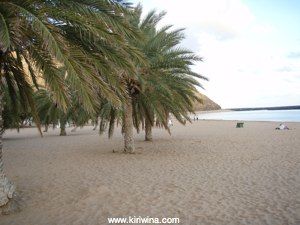
Ships lay at anchor outside a reef protecting the beach.
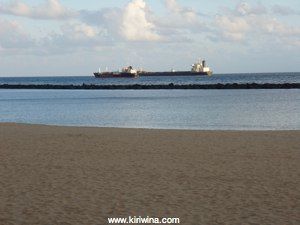
However, it's all a fake. There being few beaches in this part of Tenerife it was decided, some 40 years ago, to make one. An offshore reef was constructed and the sand was shipped in from the then Spanish sahara.
A fake it may be but it was was well built, appears well maintained and is said to be very popular though it was virtually empty on our monday afternoon visit.
But needs must. We had to be at Imprecasa, a marine servicing company, for an 08:00 appointment to get our liferaft inspected and serviced.
They are in the north of Santa Cruz. We got lost and were late.
Our liferaft is a "Forties B" 4 man valise model manufactured by RFD, a division of Survitec who are a sort of safety conglomerate.
Firstly the liferaft is removed from it's valise and the vacuum bag removed. They had to be careful as this bag (the silver foil piece at the bottom) would have to be used again due to non availabilty of spares from RFD/Survitec. The raft is only 2 years old.
Then the raft was unfolded and the gas cylinder removed. The cylinder will be tested and recharged if necessary.

Compressed air is used to first inflate the lower chamber...

... and then the upper chamber and canopy supports.
A rear view of the fully inflated raft with circular peephole just visible.

Liferaft entrance. Note insulated floor and internal webbing ladder to assist boarding.

Our fully inflated raft with orange stability pouches underneath.

This liferaft has an RORC pack which will be inspected and consumable items such as flares and batteries replaced together with any faulty components found. The raft has no food or water. These are provided using our grab bag.
We will return tomorrow for the re-packing. I plan to include a set of specs. These can be accommodated but very little else can be added.
Tomas needed to get some vaccinations done in Santa Cruz. When he was finished we set off for the north east part of Tenerife.
The island here is quite mountainous with deep valleys and dramatic but well maintained switchback roads. Road engineering in the Canaries is pretty impressive.
From what we have seen over the past few days and this morning normal Spanish service has been resumed in that the built environment on Tenerife is a bit of a mess. The innovative approach to planning and building design used on much of Lanzarote is sadly absent here.
We drove up to the Vallee de Guerra and then onto the coast at Punta Hidalgo. Our route then turned inland via Tejina and Tegueste and climbed up into the outstanding Monte de las Mercedes.
Steep mountain valleys in Monte de las Mercedes with switchback roads. The forest here is very dense but the trees are not particularly large.

Moist sea air sweeps up the north face and rolls over into the valleys.

Higher on the very moist north facing slopes the trees appear somewhat stunted and are overgrown with lichen.

Dropping down from Monte de las Mercedes we drove through Taganana and on down to the black sandy beach at Playa de San Roque where quite a surf was running.

Our route then wound down to the east coast at San Andres where we came across a little piece of paradise at Playa de Las Teresitas. How idyllic and what a change from the rugged coast and black sandy beach just a few miles away.
Golden sands, palm trees and a still lagoon. We could have been in Tahiti.

Ships lay at anchor outside a reef protecting the beach.

However, it's all a fake. There being few beaches in this part of Tenerife it was decided, some 40 years ago, to make one. An offshore reef was constructed and the sand was shipped in from the then Spanish sahara.
A fake it may be but it was was well built, appears well maintained and is said to be very popular though it was virtually empty on our monday afternoon visit.
El Teide
02/12/07 18:47
Today was El Teide day. This, the highest mountain in Spain at 3,178 metres is often shrouded in cloud as it has for most of the time since we got here.
To reach El Teide we drove up the coast from Puerto de Radazul, turned inland towards La Laguna before taking TF24 and then TF21 which run down the middle of the island.
It was a glorious clear day but not hot. As the road reached 2000m I noticed our vehicle thermometer read 7.5ºc. The visibilty was very good with El Teide free of cloud.
El Teide seen here from about 20km away. Note the lush pine forest in the foreground.
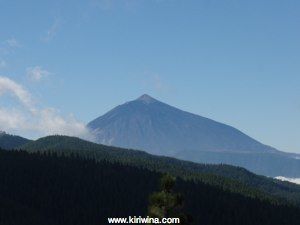
There was also a lovely view of the NW coast.
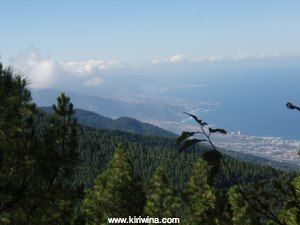
As we rose above the tree line it became very barren and bleak. Tenerife is millions of years old but the most recent eruption in the area of El Teide was only about two hundred years ago.
At the foot of El Teide (2356m) it is possible to catch a cable car, constructed by Doppelmayr of Thun, Switzerland, to within about 200m of the summit.
The cost is an eye watering €24 per person. Having come this far I decided to grit my teeth and pay up. The real price is €12 per person but non-residents of the Canaries pay a 100% surcharge. Tomas said the cost exceeded his expectation and went off to sit in the car while I went up. There was another option. We could have walked and had we had more time (a whole day and appropriate kit) we would have done so.
Taking the cable car was not a pleasant experience. The ride is wonderful but the procedure at each end is dire. This was not a visitor attraction. It was a visitor fleecing operation. Firstly one was made to queue for over half an hour next to a large open door exposed to a cold wind just to buy a ticket. It was not a busy day but the staff seemed surly and uninterested.
Once in possession of a ticket one passed through a turnstile and was hustled by a staff photographer against the wall and photographed. This was another element to the fleecing operation. Then it was necessary to negotiate an obstacle course around seating in the waiting room to reach another turnstile where one's ticket was time stamped railway style and a threatening note issued saying that time at the top was limited to one hour with the time starting at the turnstile. I.E. not one hour.
Moving on. We sheep were herded into the cable car and waited with the door open until the driver decided to proceed. What a ride! Wonderful views all around. It took about 10 minutes to go up.
Unless one has first obtained permission in Santa Cruz walking to the top is prohibited. There are two paths leading away from the cable car. I suspect these cover between a third and a half of the perimeter at cable car level and each takes about 45 minutes to complete at a relaxed pace. I wanted to do both and decided to ignore the 1 hour time limit. My flip-flops and shorts ensemble got some odd glances from kitted up serious mountain walkers. At this height (3550m) the temperature was said to be around freezing. The views were wonderful.
Looking east to Gran Canaria.
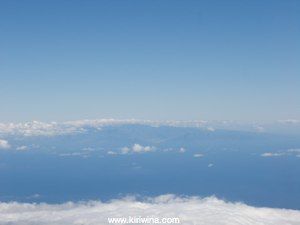
Lava flows just under cable car level and the valley below.
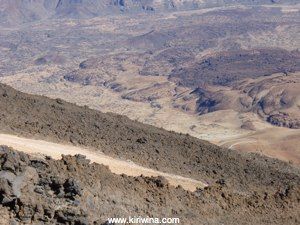
Another view to the east and Gran Canaria.
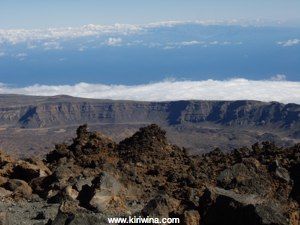
Looking south the coast of La Gomera is just visible under a flatish cloud cover.
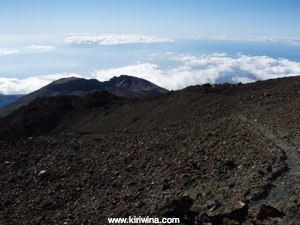
The island of La Palma is just visible above the clouds at middle right.
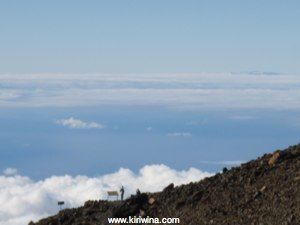
The paths wound through recent (200 years) lava fields and visibility was excellent in the vicinity of El Teide. Haze on the horizon obscured clear views of the surrounding islands.
Returning to the cable car after an hour and a half I was time checked in (no negative consequences) and after a few minutes in the waiting room we were herded into a cable car. The driver then went off to have a coffee leaving we sheep to stand in the car for about 10 minutes with the door open and exposed to the not very warm wind (0ºc).
Eventually we got underway.
Looking down from the cable car at recent lava flows.
The road below gives an indication of scale.
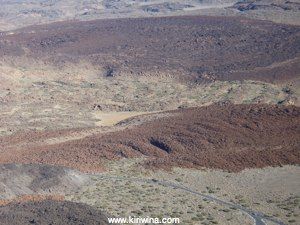
Down at the bottom we were herded through yet another turnstile to get out. Again a railway type put the ticket in before moving through. Why? They weren't done yet. One final attempt at getting more money out of us. The photographs we had been hustled into earlier were on display at €5.00 each. Tacky tacky tacky.
El Teide deserves better than this.
I rejoined Tomas in the car and noticed at a nearby mirador that large numbers of visitors were choosing not to be fleeced. Good on them!
A parting view of El Teide from the south east.
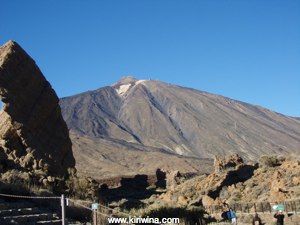
We took a long, winding and very scienic road down to the south west coast at Los Gigantes where we decided to give the south coast a miss and return by fast road to Radazul.
Just time for a quick shower before driving into Santa Cruz for a concert at the "Talon" ( Auditorio de Tenerife). We were entertained in the Sala de Cámara, the smaller of the two halls within the auditorium, by Charlie Moreno, a Spanish modern jazz guitarist of whom I knew nothing.
He was accompanied by a trio of spanish jazz musicians. Andreas Prittwitz - sax and flute, Valentin Iturat - drums and Javier Sánchez on guitar. What a treat. Over two hours of innovative music. I even bought a signed CD.
To reach El Teide we drove up the coast from Puerto de Radazul, turned inland towards La Laguna before taking TF24 and then TF21 which run down the middle of the island.
It was a glorious clear day but not hot. As the road reached 2000m I noticed our vehicle thermometer read 7.5ºc. The visibilty was very good with El Teide free of cloud.
El Teide seen here from about 20km away. Note the lush pine forest in the foreground.

There was also a lovely view of the NW coast.

As we rose above the tree line it became very barren and bleak. Tenerife is millions of years old but the most recent eruption in the area of El Teide was only about two hundred years ago.
At the foot of El Teide (2356m) it is possible to catch a cable car, constructed by Doppelmayr of Thun, Switzerland, to within about 200m of the summit.
The cost is an eye watering €24 per person. Having come this far I decided to grit my teeth and pay up. The real price is €12 per person but non-residents of the Canaries pay a 100% surcharge. Tomas said the cost exceeded his expectation and went off to sit in the car while I went up. There was another option. We could have walked and had we had more time (a whole day and appropriate kit) we would have done so.
Taking the cable car was not a pleasant experience. The ride is wonderful but the procedure at each end is dire. This was not a visitor attraction. It was a visitor fleecing operation. Firstly one was made to queue for over half an hour next to a large open door exposed to a cold wind just to buy a ticket. It was not a busy day but the staff seemed surly and uninterested.
Once in possession of a ticket one passed through a turnstile and was hustled by a staff photographer against the wall and photographed. This was another element to the fleecing operation. Then it was necessary to negotiate an obstacle course around seating in the waiting room to reach another turnstile where one's ticket was time stamped railway style and a threatening note issued saying that time at the top was limited to one hour with the time starting at the turnstile. I.E. not one hour.
Moving on. We sheep were herded into the cable car and waited with the door open until the driver decided to proceed. What a ride! Wonderful views all around. It took about 10 minutes to go up.
Unless one has first obtained permission in Santa Cruz walking to the top is prohibited. There are two paths leading away from the cable car. I suspect these cover between a third and a half of the perimeter at cable car level and each takes about 45 minutes to complete at a relaxed pace. I wanted to do both and decided to ignore the 1 hour time limit. My flip-flops and shorts ensemble got some odd glances from kitted up serious mountain walkers. At this height (3550m) the temperature was said to be around freezing. The views were wonderful.
Looking east to Gran Canaria.

Lava flows just under cable car level and the valley below.

Another view to the east and Gran Canaria.

Looking south the coast of La Gomera is just visible under a flatish cloud cover.

The island of La Palma is just visible above the clouds at middle right.

The paths wound through recent (200 years) lava fields and visibility was excellent in the vicinity of El Teide. Haze on the horizon obscured clear views of the surrounding islands.
Returning to the cable car after an hour and a half I was time checked in (no negative consequences) and after a few minutes in the waiting room we were herded into a cable car. The driver then went off to have a coffee leaving we sheep to stand in the car for about 10 minutes with the door open and exposed to the not very warm wind (0ºc).
Eventually we got underway.
Looking down from the cable car at recent lava flows.
The road below gives an indication of scale.

Down at the bottom we were herded through yet another turnstile to get out. Again a railway type put the ticket in before moving through. Why? They weren't done yet. One final attempt at getting more money out of us. The photographs we had been hustled into earlier were on display at €5.00 each. Tacky tacky tacky.
El Teide deserves better than this.
I rejoined Tomas in the car and noticed at a nearby mirador that large numbers of visitors were choosing not to be fleeced. Good on them!
A parting view of El Teide from the south east.

We took a long, winding and very scienic road down to the south west coast at Los Gigantes where we decided to give the south coast a miss and return by fast road to Radazul.
Just time for a quick shower before driving into Santa Cruz for a concert at the "Talon" ( Auditorio de Tenerife). We were entertained in the Sala de Cámara, the smaller of the two halls within the auditorium, by Charlie Moreno, a Spanish modern jazz guitarist of whom I knew nothing.
He was accompanied by a trio of spanish jazz musicians. Andreas Prittwitz - sax and flute, Valentin Iturat - drums and Javier Sánchez on guitar. What a treat. Over two hours of innovative music. I even bought a signed CD.
Puerto Cruz and NW Coast
01/12/07 18:48
Our first stop today was La Ortova, a town about 3 miles up into the hills from Puerto de la Cruz. It had little appeal apart from a section of the old quarter which featured some typical Canarian galleried houses dating from the 17th century.
Casa Ponte Fonte - 1676.
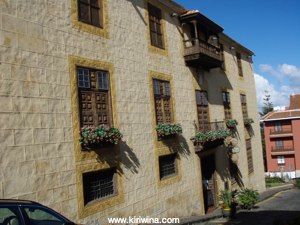
Casa de los Balcones - 1632
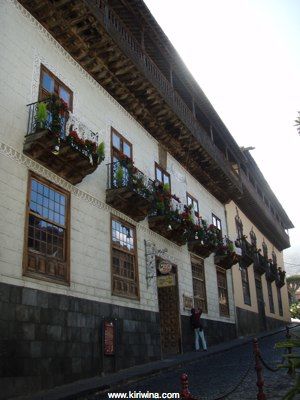
Interior courtyard - Casa de los Balcones
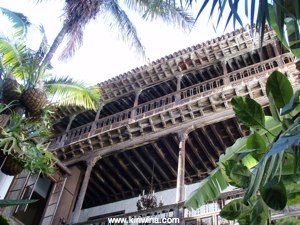
Casa de los Balcones - A device to keep insects away from food.
The cones at top and bottom are filled with something to repel insects.
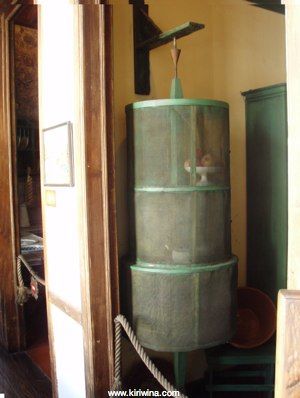
Jardines de los Marqueses de la Quinta Roja.
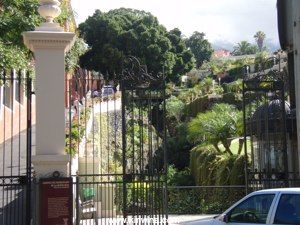
Then we drove along the north coast as far as Buenevista. A wholly inappropriate name as the town was devoid of any interest whatsoever.
On the way back we stopped at Garachico. This used to be the main port on Tenerife until destroyed by lava flows from a nearby eruption in the 18th century.
Garachico had a certain quiet charm to it. Another spot for a quiet weekend away. Perhaps at this hotel, La Quina Roja.
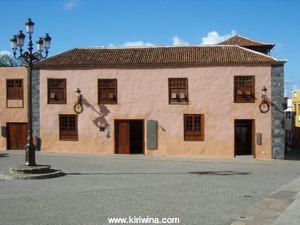
Central square - Garachico
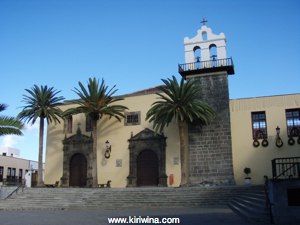
I had read about the Jardín de Aclimatación de la Orotova in Puerto de la Cruz so we went to have a look. It was quite a small garden featuring mainly tropical trees and shrubs with a lot of palm trees. The highlights were the really big trees.
A huge californian white palm.
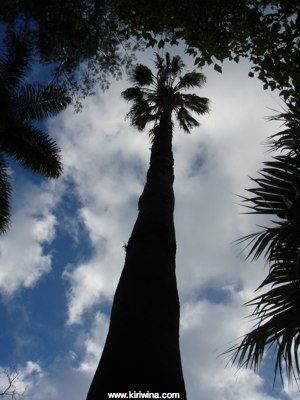
The biggest tree in the garden. A Fig from Lord Howe Island.
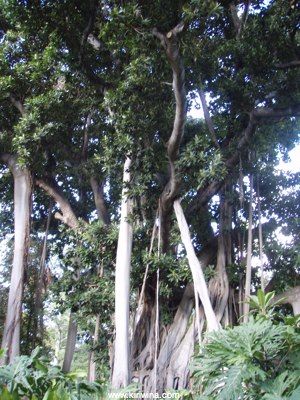
I had never seen a South African "Anchor" plant.
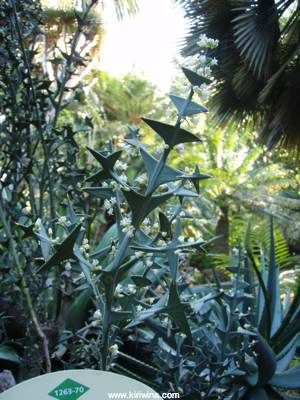
Puerto de la Cruz is a massive holiday town. There seemed to be little of interest apart from the wonderful beach garden/lido along the shoreline which was designed by César Manrique.
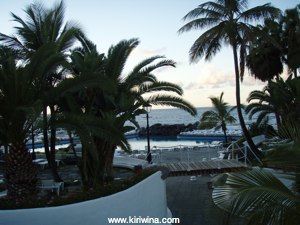
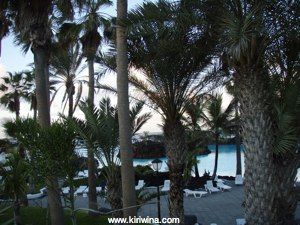
Another Manrique mobile at the entrance to his beach garden in Puerto de la Cruz.
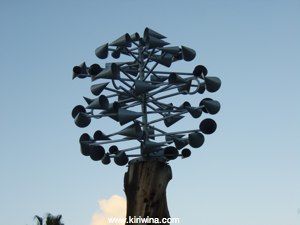
Later in the evening we had dinner, at the exotically named "Bulan Restaurante and Chill Out", with an expat who I had met in La Coruña last year. A very enjoyable evening. Thanks Pilar!
Casa Ponte Fonte - 1676.

Casa de los Balcones - 1632

Interior courtyard - Casa de los Balcones

Casa de los Balcones - A device to keep insects away from food.
The cones at top and bottom are filled with something to repel insects.

Jardines de los Marqueses de la Quinta Roja.

Then we drove along the north coast as far as Buenevista. A wholly inappropriate name as the town was devoid of any interest whatsoever.
On the way back we stopped at Garachico. This used to be the main port on Tenerife until destroyed by lava flows from a nearby eruption in the 18th century.
Garachico had a certain quiet charm to it. Another spot for a quiet weekend away. Perhaps at this hotel, La Quina Roja.

Central square - Garachico

I had read about the Jardín de Aclimatación de la Orotova in Puerto de la Cruz so we went to have a look. It was quite a small garden featuring mainly tropical trees and shrubs with a lot of palm trees. The highlights were the really big trees.
A huge californian white palm.

The biggest tree in the garden. A Fig from Lord Howe Island.

I had never seen a South African "Anchor" plant.

Puerto de la Cruz is a massive holiday town. There seemed to be little of interest apart from the wonderful beach garden/lido along the shoreline which was designed by César Manrique.


Another Manrique mobile at the entrance to his beach garden in Puerto de la Cruz.

Later in the evening we had dinner, at the exotically named "Bulan Restaurante and Chill Out", with an expat who I had met in La Coruña last year. A very enjoyable evening. Thanks Pilar!

